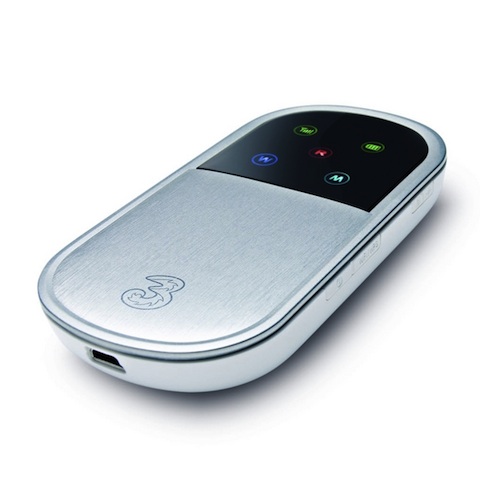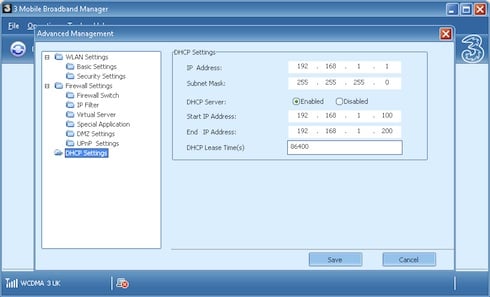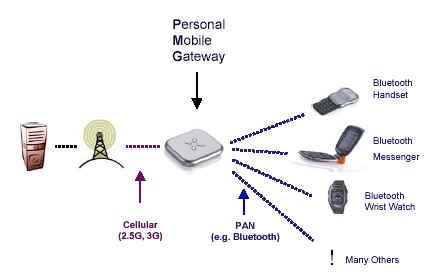Original URL: https://www.theregister.com/2009/10/14/me_and_my_mifi/
Go MiFi - and ditch your iPhone?
Is that an 'Intelligent Mobile Hotspot' - or are you just pleased to see me?
Posted in Networks, 14th October 2009 11:12 GMT
The MiFi, or the "intelligent mobile hotspot", may sound like one of the most pointless devices ever created. It's a small, battery powered gizmo that converts one wireless network protocol (3G) to another even less efficient protocol (WiFi).
Why would you want to do that, you're thinking - gain the battery inefficiencies of WiFi and combine them with the data throughput of 3G? And then put up with the extra inconvenience of carrying yet another gadget, with yet another power charger, and add another point of failure into your life? But a month with the MiFi - courtesy of network 3 UK - has prompted me to think the unthinkable, and consider ditching my iPhone. Or at least go far enough down that road to do the sums.

The personal WiFi router is sure to get smaller and cheaper, but even as it is, it has some benefits. What MiFi does is decouple the net access point from the device. This has some very interesting consequences.
One is that you can immediately use multiple devices with your connection - the phone and the laptop, for example. Perhaps more significantly, you cease to depend on your phone for your data connection - something UK users do much less now anyway, with our competitive 3G dongle market.
It's also likely to stimulate the market for data devices which aren't hulking all-in-one smartphones. Of which a good example happens to be Apple's iPod Touch. Canny operators will see this and start to bundle Touches, or devices like them, as a customer retention tool. I can even envisage some old and forgotten form factors being revived. And rather than try to do everything, the phone will gradually begin to revert to a smaller, simpler, and more dedicated voice and text tool.

3's Me-Fi: a personal WiFi router
Additionally, a decoupled connection that creates an instant WiFi hotspot means some unusual social applications become feasible, if not exactly (as yet) easy. Personal radio stations, anyone? Real, personal P2P?
And if you have several data plans - perhaps one on your smartphone, one for HotSpots like The Cloud, and a 3G dongle too - then you can start to consolidate these.
But you can probably guess which of the practical reasons were behind my iPhone epiphany. O2's data network - when it's gasping to stay alive - is atrocious. 3G coverage is poor, and in many places even the E for EDGE doesn't appear. This doesn't do the phone, which is pretty good, any justice at all. Orange and Vodafone will make hay from O2's years of underinvestment.
But remember that most of what the iPhone can do, the iPod Touch can do too. With a MiFi, I'd have a data connection wherever there's a 3 network connection. And the 3 network is a hell of a lot better than O2. So Touch applications such as Mail, Maps and Safari suddenly become viable alternatives.
Hands on with the hardware
The mobile hotspot arrived in the US in the Verizon network in the summer, and in the UK last month on the 3 network. I was using a Huawei E5830. It came with its own mini-USB AC adapter, but it also charges off a laptop and a mini-USB to USB cable is supplied. Like many recent 3G dongles, it also has a microSD card slot.
Eventually these gadgets should be as small as a keyfob, but for now it's a little-finger-width longer than a credit card and as thick as an iPhone. The circuitry is tiny, but the bulk and heft of the device is taken up by a 1,500mAh battery.
After a 12 hour first charge (why can't manufacturers or stores pre-charge these?) you slide in the SIM and are good to go. The SSID and WPA password are on one of several idiot cards included in the box, and not immediately apparent.
There are three fiddly buttons along the side: Power, one marked "WiFi/WPS" - and one with a globe being orbited. Guess what that's for? It's the modem. The indicator lights showed a similar Korean genius for simplicity and intuitive design. Network reception and Battery are obvious, but W and M (guess again) are colour coded and I had to refer to the idiot cards to tell whether I was on 2G or 3G. I suppose it's useful to have WiFi with no internet.
Despite all this with both MacBook and iPhone I was online as soon as it accepted the password.
Unfortunately, you need the cable to configure the router. Plugging it into your PC, the modem's microSD card shows up as storage, and on it is 3's Mobile Manager software - that's pretty common with 3G dongles today. Unlike Vodafone, 3 doesn't supply Mac software on this drive - or anywhere I could find.
Use this to send SMS, change the SSID to something less ostentatious than 3WirelessModem-XXXX - and choose a new default passphrase. You can also set some firewall and DNS settings. If there's a web server configuration available, let me know, I couldn't find it - and if you've configured all this from a Linux to Mac box over a port - let me know too.

3's Mobile Manager
Perhaps because it's so new, it's poorly documented. The Me-Fi isn't listed with other mobile broadband dongles in the support section of 3's website - I eventually found some support pages via a user forum. I couldn't find Huawei's own user guide.
Although it supports 802.11g, Me-Fi doesn't give you 802.11g speeds of course - merely a gateway onto 3's network. It supports HSDPA 3.6 down; I comfortably got 2 mbits/s down. It's another reason why phone tethering has all but died out - you're not constrained by the Bluetooth pipe.
Battery reception is claimed to be five hours online, but to my surprise it could sometimes chunter along quite happily for longer. On one occasion, however, it had inexplicably run down overnight with nothing connected. A bug in the power management? More annoyingly, it occasionally took some cajoling to awake from sleep. These are minor problems but should be ironed out.
The only other glitch was what I considered to be an overly complex going online sequence. Power on and wait for the lights - then make sure you've pressed both the WiFi and [GLOBE?] buttons. This won't bother most Reg readers - but can't it be simpler? To fulfil its potential, the MiFi needs to be a no-brainer - which means it should not suffer power downs, and one simple slider should take the user from "Power Off" state to "WiFi on but no modem" to "Fully On".
Pricing
So how do they economics stack up?
Here's where it gets interesting, because as you'd expect from a first-to-market product, the Me-Fi carries a slight premium.
Unsubsidised, and purchased through 3's website, a standalone MiFi is £15 for 5Gb of monthly data on pay as you go, which is highly competitive. But the MiFi costs you £69.99. Ouch. Voda gets you going for £34 which includes £15 of data - the top-ups don't expire - including the dongle. But even on Voda's postpay, you don't get as much data as 3 offer you: the 5GB monthly costs £25 for an 18 month contract.
So the appeal of the MiFi is data plan consolidation, and support for more than one device. Consolidation won't appeal to anyone with more than one mobile data plan, and it won't appeal to people who'd like their smartphone to have instant connectivity. But if you're paying for several data plans, or have several devices, and use less than 5GB, it's worth considering.
The downside is putting your eggs in one basket - and the extra inconvenience of an extra gadget to carry and keep charged. In practice, I didn't find the power issue too much of a nuisance - it charges from a laptop's USB port. I'm still cursing the three-stage power up procedure. The potential is what's quite interesting.
Conclusion: is this a disruptive dongle?
Readers with long memories may remember an Israeli company that tried the same concept around six or seven years ago. Back then it was a Bluetooth based PAN, and the company - IXI - called it a personal mobile gateway.

A Bluetooth watch on every wrist! The future as seen from the PAN era, c.2002
It was probably too early to market - Bluetooth headsets hadn't yet conquered the Chav market - and it was swept aside as manufacturers looked to incorporate low cost 802.11b into devices. That was classic technology looking for a solution.
But the MiFi opens lots of avenues for imaginative operators, if that isn't an oxymoron. A canny operator should be able to offer subsidised Apple iPod Touches (or similar devices) for music, email, browsing - and perhaps add a "Phone Manager" application, all bundled with a MiFi.
Then there's the tantalising possibility of new services. I've advocated "social hardware" - or peer-to-peer uses of mobile for almost a decade. Here's a piece on what you can do with discovery services over personal area networking, from about six years ago, for example. Many of these are users that infringe copyright, but many technologies were copyright infringing at birth. Rights holders should exploit them, not outlaw them, for the enrichment of creators.
The MiFi makes these more possible. Just as pals on a night out have a designated driver - I wonder if we'll have a "designated router"? ®